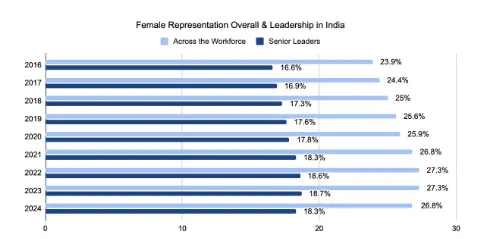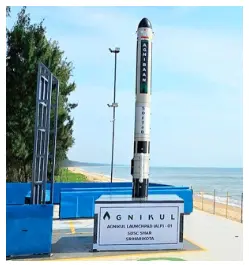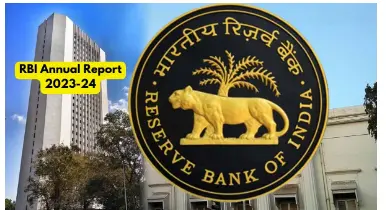Thursday, 6th June 2024
Coalition Government and Economic Governance
In News:
- Recently, the National Democratic Alliance (NDA) has secured a third consecutive term at the Centre, but the Bharatiya Janata Party (BJP) fell short of the 272 majority, necessitating a coalition government.
- India's economic history since 1991 shows that coalition governments have initiated some of the most transformative reforms, laying the foundation for the country's resurgence.
|
Coalition Government
|
Notable Reforms Brought by Previous Coalition Governments
Under the P V Narasimha Rao-led Government:
- It discarded centralised planning and opened the Indian economy to global competition by removing the licence-permit raj.
- The country became a member of the World Trade Organisation.
- Since 1991, when India was compelled to open its economy and abandon the planned economy model, all governments were coalitions where even the lead party was far from a majority.
Under the short-lived Deve Gowda Government:
- It introduced the "dream budget," which reduced tax rates for personal income, corporate taxes, and customs duties, showing faith in Indian taxpayers.
Under the Atal Bihari Vajpayee-led Government:
- It enacted the Fiscal Responsibility & Budget Management (FRBM) law for fiscal discipline, limiting the government's borrowing within prudential limits.
- It advanced the disinvestment of loss-making Public Sector Undertakings (PSUs).
- It focused on rural infrastructure and connectivity through the PM Gram Sadak Yojana.
- It introduced the Information Technology Act in 2000, laying the foundation for India’s burgeoning e-commerce sector.
Under the Manmohan Singh-led Government:
- It implemented several rights-based reforms, providing robust guarantees beyond personal assurances.
- The Right to Information Act boosted transparency in India's democracy.
- The Right to Food ensured no Indian would go hungry.
- The Mahatma Gandhi National Rural Employment Guarantee Act (MG-NREGA) provided minimum employment to the rural poor.
- It deregulated fuel prices and initiated work on direct benefit transfers, Aadhaar, and GST before leaving office.
The Statistics:
- BJP-led Majority Government (10-year period): Average growth rate: 6%, including a 5.8% contraction in FY21 amid Covid-related disruptions.
- BJP-led Government (2014-2019): Achieved an average annual growth of 7.4% in its first term, the fastest since 1989.
- Congress-led United Progressive Alliance (UPA) Government: Achieved 6.7% growth in its five years preceding the BJP government in 2014. Recorded 6.9% growth in the previous five years of its first term. The compound annual growth rate (CAGR) during its 10-year rule was 6.8%, the fastest in India’s history.
- Growth between 1991 and 1999: Averaged 5.6%, spanning from Congress forming a minority coalition with Janata Dal to Atal Bihari Vajpayee-led NDA returning to power.
- Concerns Faced by Coalition Government:
- Inflation for industrial workers was 5.4% during the last decade, when the BJP had an absolute majority, but was 10.3% for UPA’s second stint and 6% in the first one.
- While it was low for Vajpayee’s years between 1999 and 2004, industrial worker inflation was 9.6% between 1991 and 1999.
Can a coalition government derail India’s economic reforms trajectory?
- This is not true in the Indian context as many notable reforms were brought by the previous coalition governments. Coalition govt and economic reform - strong consensus for weak reforms.
- Coalition govts in India have historically faced challenges in implementing strong economic reforms due to differing priorities among coalition partners.
- Diverse Interests: Coalition partners often have varied political and economic agendas, leading to compromises and diluted reforms. This can slow down or alter the trajectory of economic reforms.
- Consensus Building: While coalition governments can foster broader consensus, the need to appease various factions might lead to weaker reform measures. Achieving a unified stance on complex economic issues becomes difficult.
- Policy Stability Frequent changes in coalition partners or internal disagreements can lead to policy instability, affecting investor confidence and long-term economic planning.
Source: IE
Draft Digital Competition Bill 2024
In News:
- India has proposed a new digital competition law to curb practices by tech giants like Google, Facebook, and Amazon that involve favouring their own services or using data from one business to benefit another within the same company.
- The ministry of corporate affairs (MCA) formed a Committee on Digital Competition Law, which recommended a new Digital Competition Act.
- This act aims to introduce proactive legislation specifically targeting large digital companies, complementing the existing Competition Act.
|
Digital Competition Bill 2024:
|
Need for Digital Competition Bill:
- Inadequacy of Current Ex-Post Antitrust Framework: The existing antitrust framework under the Competition Act, 2002, reacts to violations after they occur, often too late to protect competition. The Digital Competition Bill (DCB) proposes an ex-ante approach to prevent violations before they disrupt the market.
- Addressing Monopolistic Actions: Recent fines imposed on big-tech companies like Google for anti-competitive behaviours highlight the necessity for stringent regulations. The DCB aims to establish clear guidelines to prevent such dominant practices upfront.
- Anti-Competitive Practices by Big-Tech Companies: Big-tech companies have a documented history of engaging in anti-competitive practices. For instance, in 2023, Google was fined Rs 1.337 crore by the Competition Commission of India (CCI) for its anti-competitive conduct in the Android ecosystem.
- Facilitating New Entrants and Innovation: The current digital market structure disproportionately favours big tech, deterring new competitors. The DCB seeks to dismantle these barriers, fostering innovation and diversity within the marketplace.
- Ensuring Fair Competition: The dominance of big tech often overshadows smaller entities, making competition inequitable. The DCB focuses on creating conditions that allow smaller companies to compete on a level playing field.
- Promoting Systematic Growth and Fairness: The digital competition bill aims to guide the growth of the digital ecosystem towards fairness and competitive equity, addressing issues such as arbitrary pricing and anti-competitive practices.
Key Proposals of the Draft Digital Competition Bill:
- Predictive Regulation: The bill proposes a forward-looking, preventive ex-ante framework to foresee and prevent potential antitrust issues, setting clear no-go areas in advance, similar to GDPR for data privacy. The current ex-post framework under the Competition Act, 2002, involves delays and excludes smaller competitors.
- Enlisting of Core Digital Services: The bill lists "core digital services" under Schedule I, including online search engines, video-sharing platforms, social networking services, interpersonal communications, operating systems, web browsers, cloud services, advertising services, and online intermediation services like web-hosting and payment sites.
- Provision of Significant Entities: The bill designates certain enterprises as Systemically Significant Digital Enterprises (SSDEs) based on turnover, user base, market influence, etc. Entities not meeting these criteria can still be designated as SSDEs by the CCI if they have a significant presence in any core digital service.
- Responsibilities of SSDEs: SSDEs are prohibited from practices like self-preferencing, anti-steering, and restricting third-party applications. For example, Google cannot favour its own services over competitors. Violations can result in fines up to 10% of global turnover.
- Designation of Associate Digital Enterprises (ADE): The bill designates associate digital enterprises (ADEs) to recognize the impact of data sharing within a tech group. ADEs would have the same obligations as SSDEs, depending on their involvement with the core digital service offered by the main company.
Criticism of the Draft Digital Competition Bill:
- Compliance Burden: Big tech companies argue that the ex-ante framework imposes heavy compliance costs, diverting attention from innovation to regulatory adherence. Example: The EU’s Digital Markets Act (DMA) increased Google search time by 4,000%, causing delays and inefficiencies.
- Impact on Innovation: Tech giants prefer strengthening current competition laws over the new framework, fearing it might stifle innovation. Example: Apple opposes allowing third-party app stores on iPhones, citing concerns about security and user experience.
- Broad Definitions: Companies worry about the broad and discretionary definitions of significant platforms, leading to uncertainty. Example: Unlike the EU’s DMA, India’s draft leaves the determination of 'gatekeeper' entities to the CCI, causing ambiguity.
- Potential Arbitrary Decisions: Discretion given to the CCI could result in arbitrary decision-making, affecting startups and small businesses.
- Impact on Smaller Businesses: Changes in data sharing and platform policies may harm smaller businesses reliant on these platforms to reach audiences. Example: Reducing data sharing could hinder small businesses' ability to effectively target customers on major digital platforms.
- Industry Concern: The Internet and Mobile Association of India (IAMAI) expresses apprehensions about the draft Digital Competition Bill 2024, fearing adverse effects on startups and digital enterprises. They argue that proposed regulations could deter venture investments in technology startups.
Governance Frameworks to Regulate Technologies for Responsible Use:
- Competition Act 2002 and CCI: The Competition Act 2002 addresses antitrust issues and regulates Big Tech Companies in India. It establishes the Competition Commission of India (CCI) to monitor monopolistic practices and ensure fair competition.
- Competition Amendment Bill, 2022: This bill enhances CCI’s review process, particularly for digital and infrastructure sectors, by requiring regulations to evaluate significant business operations in India.
- Information Technology Act, 2000: The Act offers a legal framework for electronic governance, recognizing electronic records and digital signatures. However, it lacks provisions for addressing modern technology misuse.
- Multi-stakeholder Initiatives: Collaboration among governments, businesses, and academia for technology governance. Examples include the Global Network Initiative (GNI) and Partnership on AI (PAI).
- RBI Directions and Vision documents: The RBI issues directives and regulations to oversee big tech companies' activities in the fintech sector regularly.
Conclusion:
The Draft Digital Competition Bill marks a significant stride in fostering fair competition and curbing monopolistic practices in India’s digital markets. To ensure its effectiveness, balanced implementation and active engagement with stakeholders will be crucial for promoting sustainable digital growth.
Source: IE
Tonga Volcano Impacting Weather
In News:
- A recent study published in the Journal of Climate revealed that the Hunga Tonga-Hunga Ha’apai (Hunga Tonga for short) eruption in 2022 in the Pacific Kingdom of Tonga could cause unusual weather for the rest of the decade.
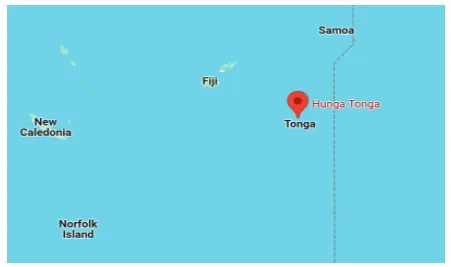
Cooling Effect by Volcanic Smoke:
- Volcanic smoke, particularly its sulfur dioxide, usually causes short-term cooling of the Earth’s surface.
- Sulfur dioxide forms sulfate aerosols that reflect sunlight back into space before it reaches the surface. This shading effect cools the surface until the sulfate settles or is washed away by rain.
Why is Hunga Tonga’s Eruption an Outlier?
- The Hunga Tonga’s eruption will not cause a cooling effect on the Earth’s surface. This is because it was an underwater volcano, so it produced little smoke but a lot of water vapour.
- The eruption’s immense heat turned large amounts of seawater into steam, which was propelled high into the atmosphere.
- All that water had reached the stratosphere (15 to 40 km above the surface), which is a dry atmospheric layer that produces neither clouds nor rain.
- Water vapour in the stratosphere has two main effects:
- It helps in the chemical reactions which destroy the ozone layer.
- It is a very potent greenhouse gas.

The Effects of the Hunga-Tonga Volcano on the Climate:
Extraordinary Ozone Hole in 2023:
- Water Vapour Emission: The Hunga Tonga underwater volcano eruption released 100-150 million tonnes of water vapour, increasing stratospheric water vapour by approximately 5%.
- Ozone Layer Destruction: This surge in water vapour contributed to ozone layer depletion and acted as a potent greenhouse gas.
- Timing of Ozone Hole: The large ozone hole from August to December 2023 was partly due to the Tonga eruption. The water vapour had nearly two years to reach the polar stratosphere over Antarctica, leading to the early appearance of the ozone hole.
Wet Summer of 2024 in Australia
- Positive Southern Annular Mode: The model predicted a positive phase of the Southern Annular Mode for the summer of 2024, indicating a higher likelihood of a wet summer in Australia.
- Contrary to El Niño: This forecast was contrary to the expected El Niño conditions and was predicted two years in advance by the model.
Regional Weather Disruptions
- Australia: Colder and wetter winters for the northern half of Australia are expected until around 2029.
- North America: Warmer winters are anticipated.
- Scandinavia: Colder winters are predicted.
- Influence of Atmospheric Waves: The Tonga eruption's impact on atmospheric wave patterns influences these regional weather conditions, underscoring the need for region-specific climate predictions and adaptation strategies.
Global Temperature Effects:
- Small Temperature Change: The eruption's impact on global mean temperatures was minimal, estimated at around 0.015°C.
- Temperature Observations: The high global temperatures observed for about a year were not attributed to the Tonga eruption.
|
UPSC Civil Services Examination, Previous Year Question (PYQ) Prelims Q:1 Consider the following: (2013)
Which of the above are responsible for bringing dynamic changes on the surface of the earth? (a) 1, 2, 3 and 4 only (b) 1, 3, 5 and 6 only (c) 2, 4, 5 and 6 only (d) 1, 2, 3, 4, 5 and 6 Ans: (d) Mains: Q:1 Discuss about the vulnerability of India to earthquake related hazards. Give examples including the salient features of major disasters caused by earthquakes in different parts of India during the last three decades. (2021) Q:2 Why are the world’s fold mountain systems located along the margins of continents? Bring out the association between the global distribution of fold mountains and earthquakes and volcanoes. (2014) Q:3 Mention the global occurrence of volcanic eruptions in 2021 and their impact on the regional environment. (2021) |
Pradhan Mantri Kisan Samman Nidhi (PM-Kisan) Scheme
In News:
- According to the report by the Union Ministry of Agriculture & Farmers Welfare (MoA&FW) from June 2023 to May 2024, approximately 116,000 farmers nationwide voluntarily opted out of the annual Rs 6,000 PM-Kisan scheme.
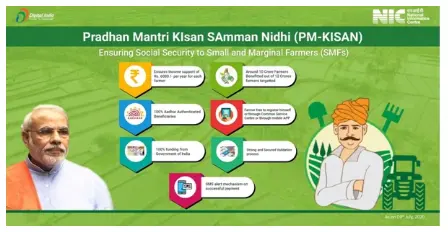
PM Kisan Samman Nidhi (PM-Kisan) Scheme:
- The PM-Kisan Yojana, a central government initiative launched on February 24, 2019, aims to provide financial support to landholding farmers' families across India.
- Under this scheme, eligible beneficiaries receive Rs. 6000 per year in three instalments of Rs. 2000 each, directly transferred to their bank accounts through Direct Benefit Transfer (DBT).
- The scheme, administered by the Ministry of Agriculture & Farmers Welfare (MoA&FW), commenced with the transfer of the first instalment to 3.03 crore beneficiaries for the Dec-March 2018-19 cycle.
- It provides additional financial assistance to farmers for purchasing various inputs necessary for agriculture, thereby ensuring good crop yields and meeting domestic needs.
- The PM-Kisan Yojana is funded entirely by the central government, with the identification of eligible farmer families carried out by state and union territory governments.
Farmers Opting Out or Excluded from PM-Kisan Scheme:
- Voluntary Exit Option: The Ministry of Agriculture & Farmers Welfare (MoA&FW) introduced a feature in the PM-Kisan mobile app and website allowing farmers to voluntarily exit the scheme if they choose to do so.
- Surrendered Benefits: In Bihar, the highest number of farmers' families (29,176) surrendered their PM-Kisan benefits, followed by Uttar Pradesh (26,593) and Rajasthan (10,343).
- Possible Reasons for Opting Out: Farmers may choose to relinquish PM-Kisan benefits due to reasons such as absentee landlords deciding against availing the subsidy, land ownership transferring to tax-paying descendants who are ineligible, or changes in the status of land ownership.
- Exclusion of Ineligible Farmers: The central and state governments removed many ineligible farmers from the PM-Kisan database, resulting in a decrease in the number of beneficiaries from 10.47 crore in April-July 2022 to 8.12 crore in November 2023.
Benefits of the PM-KISAN Samman Nidhi scheme:
- Direct Benefit Transfer (DBT) Advantages: By leveraging DBT, the scheme eliminates intermediaries, ensuring direct fund transfers to farmers' accounts, thereby enhancing transparency and efficiency in disbursals.
- Inclusive Coverage: Irrespective of land holdings, the program extends its benefits to all farmer families nationwide, ensuring comprehensive coverage and equitable distribution of financial assistance.
- Digital Transformation: Through the adoption of digitization, farmer records are systematically maintained on official digital platforms, simplifying registration processes and enabling seamless fund transfers, thereby reducing administrative burdens.
- Enhancing Farmer Liquidity: The scheme plays a crucial role in alleviating liquidity constraints faced by farmers, providing them with greater financial flexibility to manage agricultural expenses, invest in allied activities, and meet domestic needs.
- Greater Coverage: Ensuring inclusivity, the scheme covers all farmer families across the country, regardless of the size of their land holdings, thereby ensuring that no eligible farmer is left behind.
- Agricultural Reforms: The scheme serves as a catalyst for agricultural reforms, fostering the adoption of new systems and technologies across the agricultural value chain, from seed to market. It also facilitates reforms in existing agricultural practices, aiming to enhance productivity and sustainability in the sector.
Challenges Facing the PM-KISAN Scheme:
- Insufficient Financial Support: The scheme's effectiveness heavily relies on providing substantial financial aid to farmers, ensuring they have the purchasing power to meet their basic needs. However, the cash transfer is not tied to the size of the farmer's land, potentially limiting its impact.
- Limited Reach to All Farmers: Despite its pro-poor objectives, PM-KISAN appears to primarily benefit recipients who were relatively better off even before the scheme's implementation. This raises concerns about its inclusivity among the broader rural population.
- Exclusion of Landless Farmers: The scheme's eligibility criteria exclude impoverished rural households without land ownership, leading to the exclusion of a significant portion of the rural population in need of financial assistance.
- Implementation Challenges: PM-KISAN's top-down implementation approach overlooks governance constraints, leading to challenges in its effective execution at the grassroots level. Addressing these challenges is crucial for ensuring the scheme's success and reaching its intended beneficiaries.
- Structural Concerns: Shifting budgetary allocations significantly towards cash transfers may raise concerns about the scheme's long-term impact on agricultural markets and crucial infrastructure areas such as irrigation. Balancing short-term financial support with long-term investments remains a key challenge for policymakers.
Source: IE
Two lakh plus NOTA votes in Indore
In news:
- In The Recent Lok sabha election in Indore, BJP's Shankar Lalwani secured a resounding victory with a remarkable margin of 10.09 lakh votes, garnering a total of 12,26,751 votes.
- Interestingly, the nearest contender was NOTA, amassing 2,18,674 votes. This outcome marks the highest count of NOTA votes ever recorded in any constituency.
- Previously, the record stood at 51,660 NOTA votes in Gopalganj, Bihar, during the 2019 elections.
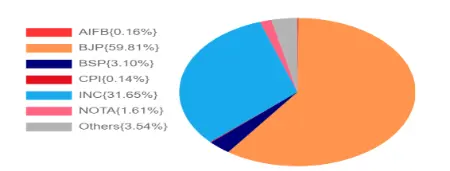
|
NOTA:
|
What are the Landmark Cases Related to NOTA?
Lily Thomas v. Speaker, Lok Sabha (1993):
- The Supreme Court held that “Voting is a formal expression of will or opinion by the person entitled to exercise the right on the subject or issue in question” and that “right to vote means right to exercise the right in favour of or against the motion or resolution. Such a right implies the right to remain neutral as well”.
People's Union for Civil Liberties & Anr v. Union of India & Anr (2013):
- In 2004, the People's Union for Civil Liberties filed a PIL.
- The Supreme Court mandated the provision of a "None of the Above" (NOTA) button on EVMs to allow voters to express dissatisfaction with contesting candidates while maintaining secrecy.
- This decision came to enhance democracy by empowering voters and promoting fair elections.
- The Election Commission was directed to implement this provision with government assistance, along with conducting awareness programs.
Shailesh Manubhai Parmar v. Election Commission of India Through the Chief Election Commissioner & Ors. (2018):
- The Supreme Court held that “The option of NOTA may serve as an elixir in direct elections but in respect of the election to the Council of States which is different from other elections, it would not only undermine the purity of democracy but also serve the Satan of defection and corruption.
- Hence the court scrapped NOTA from Rajya Sabha elections.
What are the Legal Provisions related to NOTA?
Article 21 of the Universal Declaration of Human Rights:
- It ensures voting secrecy, aligning with the principle that government authority derives from the people's will, as outlined in genuine elections conducted through universal suffrage and secret ballot, as mentioned in the article.
Section 25(b) of International Covenant on Civil and Political Rights:
- The provision ensures universal suffrage, allowing citizens the right to vote and stand for elections freely and fairly, without discrimination or undue restrictions. Elections must be genuine, periodic, and conducted via secret ballot, ensuring the unfettered expression of voters' will.
Section 79(d) in The Representation of the People Act, 1951:
- “Electoral right” means the right of a person to stand or not to stand as, or to withdraw or not to withdraw from being, a candidate, or to vote or refrain from voting at an election.
What happens if NOTA receives the highest number of votes in a constituency?
NOTA's Legal Implications:
- Experts emphasise that if NOTA receives the most votes, it holds no legal consequence; the candidate with the second-highest votes is declared the winner.
- While NOTA hasn't impacted Lok Sabha elections in this manner, instances like the Indore case indicate its potential.
Supreme Court Involvement:
- Currently, the Supreme Court is deliberating on a petition regarding the nullification of elections if NOTA secures the highest votes.
- Filed by Shiv Khera in April 2024, the petition seeks uniform implementation of NOTA by the Election Commission of India (ECI) and repercussions for candidates failing to surpass NOTA.
Petition's Highlights:
- Khera's petition cites instances from various states like Maharashtra, Haryana, Puducherry, Delhi, and Chandigarh, where NOTA is treated as a "Fictional Electoral Candidate" in local elections.
- It suggests that if NOTA outvoted individual candidates, fresh elections should be conducted.
Arguments Presented:
- The petition advocates for consistent rules across all elections where NOTA secures a majority.
- It argues that NOTA, since its inception in 2013, hasn't led to increased voter participation or enhanced candidate quality.
- Describing NOTA as a "potent weapon," the petition stresses the need for greater impact to compel political parties to improve.
- Additionally, it proposes barring candidates receiving fewer votes than NOTA from contesting elections for five years and urges the Supreme Court to direct the ECI to formulate such regulations
Conclusion:
Hence, NOTA serves as a valuable tool for voters to express dissent without abstaining from the electoral process altogether. It formalises protest votes, indicating dissatisfaction with the candidate pool to political parties. This mechanism enhances transparency and accountability in the democratic process, empowering citizens to voice their concerns effectively.
Source: IE
Rewilding of Vultures in Tiger Reserves
In News:
- Under the vulture reintroduction programme by the Bombay Natural History Society (BNHS), 20 vultures were soft-released into the Tadoba and Pench tiger reserves in Maharashtra.
- More vultures from the white-rumped, slender-billed, and long-billed vultures bred at various BNHS centres will be rewilded in Maharashtra, Madhya Pradesh, and Rajasthan.
- BNHS undertook the strategy of reintroducing vultures in tiger habitats with a large prey base because it will help sustain the vultures by allowing them to recycle the remains of prey hunted by tigers, leopards, and wild dogs and complete vital carbon and nitrogen cycles.
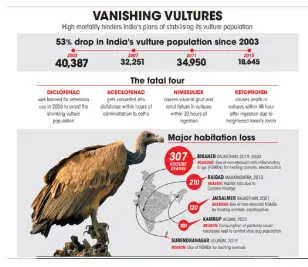
|
Reasons Behind the Massive Reduction in Vulture Population
Diclofenac:
- ‘Diclofenac’, a veterinary drug used to treat cattle, caused mass kidney failure in vultures after they scavenged treated livestock.
- The massive vulture population crash in the ’80s and ’90s caused by this led the International Union for Conservation of Nature (IUCN) to declare the Indian vulture “only one step away from total extinction.” By 2007, 99% of vultures in India had disappeared.
- Following the findings, the GoI had banned the drug’s veterinary use in 2006.
Consequences of Depopulation of Vultures
- Vultures played an important role as natural sanitation crews. Their depopulation results in:
- The carcasses rot in village fields, leading to contaminated drinking water.
- Explosion of rats and wild dogs, which lead to the spread of diseases.
- A vulture’s metabolism is a true “dead-end” for pathogens. However, the new scavengers (dogs and rats) become carriers of the pathogens.
BNHS’s Efforts to Conserve India’s Vulture
- About a decade ago, BNHS and the forest departments of Maharashtra, MP, Assam, WB, and Haryana began breeding vultures, gaining international attention at the first World Species Congress.
- BNHS teams conduct pharmacy surveys and carcass sampling, educate cattle owners, and sensitise villagers about vulture nesting colonies.
- BNHS is also raising funds to create ‘Vulture Safe Zones’ in UP, MP, and Assam, within a 100 km radius of the release sites, to keep vultures safe beyond the tiger reserves.
- They will GPS or satellite-tag the rewilded vultures to track their movements.
|
Vultures Found in India
Resident Vulture Species of India White-Rumped Vulture
Indian Vulture/Long-billed vulture
Slender-Billed Vulture
Red-Headed Vulture/Asian King Vulture/Indian Black Vulture/Pondicherry Vulture
Bearded Vulture
Egyptian Vulture/Scavenger Vulture/Pharaoh’s Chicken
Migratory Vulture Species of India Cinereous Vulture/Black Vulture/Monk Vulture
Eurasian Griffon Vulture
Himalayan Griffon Vulture
|
Source: (TOI)
Speciation without geographic barriers
In News :
- Researchers at IIT Bombay discover the role of environmental resources, genes and mating in species in the development of new species in the same area.
Speciation:
- Speciation is the process of formation and evolution of new species. The study challenges the traditional view of Allopatric speciation.
- Allopatric speciation occurs in species isolated from each other by geographical barriers.
- It has shed light on speciation in the absence of geographic barriers –> Sympatric speciation.
Findings of study:
- The researchers used a genetic-based model to investigate the factors that contribute to speciation when populations live in the same geographic area.
- This theoretical study focused on a population of birds using simulated data. It focused on a physical trait of the birds – the beak size.
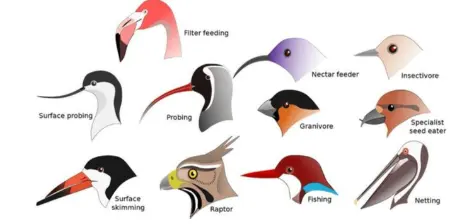
- Adaptation in beak size to best utilise two types of food resources: nuts and flower nectar.
- Birds with small beaks will be better at utilising resource nuts, while longer beaks are needed for utilising flower nectar as their resource.
- It examined three aspects that encourage speciation: disruptive selection, sexual selection, and genetic architecture.
Ecological disruptive selection:
- The “divide” can be created by non-uniform environmental resources in sympatric speciation.
- Disruptive selection favours heritable differences in the population.
- It ensures that the offspring of mating of individuals belonging to two different groups do not survive.
Role of sexual selection:
- Sexual selection, on the other hand, is a type of natural selection driven by competition for mates.
- It can lead to the evolution of elaborate traits that are attractive to potential mates.
- A ‘bias’ towards a trait like feather colour can evolve, leading to sympatric speciation.
- For example, consider a bird population with two types of feathers—blue and red. If a bias among the bluebirds to only mate with their kind evolves, it can lead to sympatric speciation in two distinct species.
- Surprisingly, the researchers found that sexual selection based on special traits did not contribute to speciation in sympatry.
- The study also acknowledges the possibility of lower fitness of the offspring due to sexual selection.
Genetic architecture:
- Researchers discovered that genetic architecture, or how genes control the trait under selection, was a crucial factor in sympatric speciation.
- However, results are limited by the assumption that birds from the two groups mate without any bias and that this bias does not change with time.
Source: (TH)
India’s Economic Growth Outlook
In News:
- S&P Global has upgraded India's outlook from stable to positive, citing policy stability, ongoing economic reforms, and significant infrastructure investments as factors supporting sustained long-term growth.
India’s Recent Economic Growth Projections:
- IMF Projection (World Economic Outlook, April 2024): The IMF raised India's GDP growth forecast for FY 2024-25 to 6.8%, up by 0.3 percentage points from its January 2024 projection. For FY 2025-26, the IMF forecasts India's GDP growth at 6.5%.
- United Nations Projection (World Economic Situation and Prospects, mid-2024): India's economy is projected to grow by 6.9% in 2024 and 6.6% in 2025. The 6.9% growth forecast for 2024 marks an upward revision from the earlier 6.2% projection made in January 2024.
- Reserve Bank of India: The Reserve Bank of India expects India's real GDP to grow by 7% in 2024-25. The GDP growth is pegged at 7.2% in the June 2024 quarter, and is expected to moderate to 6.8% in the September 2024 quarter.
The Major Factors Propelling Economic Growth in India:
Strong Domestic Demand:
- Deloitte reports a robust 3.5% year-over-year growth in private consumption expenditure in Q3 of FY 2024, fueled by increasing incomes and a growing middle class. Additionally, demand for luxury and premium goods and services is outpacing that for basic goods.
Robust Investment Activity:
- Private investment surged by 10.6% year-over-year in Q3 of FY 2024, signalling a strong revival in private capital expenditure. Initiatives such as the National Monetization Pipeline aim to unlock value in Brownfield infrastructure assets, attracting private investment.
- The IMF suggests that liberalising foreign investment and boosting exports could further bolster growth. Government-budgeted expenditure classified as capex is projected to rise to approximately ₹11 trillion in 2024-25, nearly 4.5 times the level in 2014-15.
Moderating Inflation:
- Retail inflation stood at 4.83% in April 2024, signalling a downward trajectory. This stable environment fosters spending and investment by providing businesses and consumers with confidence.
Manufacturing Resurgence:
- The manufacturing sector expanded by 11.6% year-over-year in Q3 of FY 2024, propelled by initiatives like Make in India and PLI schemes. The government's emphasis on self-reliance (Atma Nirbhar Bharat) is enhancing domestic manufacturing capabilities.
Services Sector Resilience:
- Accounting for a significant share of India's GDP, the services sector grew by 7% year-over-year in Q3 of FY 2024. The IT and IT-enabled services sector continues to drive growth, buoyed by increasing global demand for digital solutions.
- With the relaxation of Covid-19 restrictions, contact-intensive services like tourism, hospitality, and entertainment have experienced a robust recovery. The travel market in India is anticipated to reach USD 125 billion by FY 2027.
Resilience to Global Headwinds:
- Despite global economic uncertainties, geopolitical tensions, disruptions in supply chains, and tightening financial conditions in major economies, India's domestic demand has remained resilient.
- In 2023, while world food prices saw a significant decline, India's food inflation remained high at 9.5% in December 2023, in contrast to global deflation of -10.1%.
- This resilience to external shocks has sustained growth, even as major economies face slowdowns or recessions.
Supply Chain Diversification:
- Amid global supply chain disruptions, India has emerged as an attractive destination for manufacturing investments, particularly in electronics and pharmaceuticals.
- Trade agreements like the India-UAE Comprehensive Economic Partnership Agreement (CEPA) have facilitated this supply chain diversification
Major Challenges in India’s Economic Growth:
- Employment Challenges: Despite consistent GDP growth, India faces the issue of jobless growth, with unemployment at 8.1% in April 2024 according to CMIE's Consumer Pyramids Household Survey.
- Export Competitiveness Challenges: Despite policy support, India's exports declined by 3% in FY24, with a merchandise trade deficit of USD 19.1 billion in April 2024.
- Potential Fiscal Slippage Risks: S&P Global projects India's general government fiscal deficit to be 6.8% of GDP by FY28, posing risks to credit ratings and borrowing costs if the fiscal consolidation path is deviated from.
- Skill Mismatch and Labor Quality: India grapples with a skills gap, as only 45% of graduates are deemed employable. This mismatch hampers productivity and job creation.
- Income Inequality: India's wealth disparity is pronounced, with the top 1% owning 40.1% of wealth. The Gini coefficient stood at 0.4197 in 2022-23, reflecting significant income inequality.
- Informal Sector Dominance: Approximately 83% of India's workforce is employed in the informal sector, characterised by low wages and limited social security benefits. This hinders economic growth and formalisation efforts.
- Infrastructure Bottlenecks: Despite recent strides, India's infrastructure deficit persists, particularly in power, transportation, and logistics. The NITI Aayog estimates a need for USD 4.5 trillion in infrastructure spending by 2040 to sustain growth.
Measures can India Adopt to Accelerate Economic Growth:
- Expanding Manufacturing Sector: To bolster job creation and absorb transitioning agricultural workers, targeted training programs and incentives for industries can be introduced. Promoting food processing industries can also enhance income opportunities for farmers.
- Gig Economy Skilling: Partnering with online platforms can facilitate micro-skilling programs relevant to the gig economy, offering in-demand skills for immediate job opportunities. A national online marketplace for freelance work can connect skilled individuals with businesses, fostering flexible work arrangements.
- Export Processing Zones (EPZs) 2.0: Establishing sustainable EPZs with tax breaks and streamlined regulations can attract green technology and high-value manufacturing companies. Financial incentives and training programs can prepare SMEs for e-commerce exports.
- Smart Taxation and Revamped PPP: Leveraging technology for "smart taxation" and partnering with fintech companies can improve tax collection. Developing performance-based PPPs attracts private capital for infrastructure projects while ensuring value for money.
- Industry-Academia Collaboration: Strengthening collaboration between universities and industries can align curriculum with industry needs. Introducing micro-credentials allows individuals to continuously upskill and adapt to job demands.
- Green Infrastructure Bonds: Issuing green infrastructure bonds attracts private capital for sustainable projects like renewable energy. Utilising big data analytics and artificial intelligence optimises resource allocation for infrastructure development.
|
UPSC Civil Services Examination, Previous Year Questions (PYQs) Prelims Q:1 In the ‘Index of Eight Core Industries’, which one of the following is given the highest weight? (2015) (a) Coal production (b) Electricity generation (c) Fertiliser production (d) Steel production Ans: (b) Q:2 Increase in absolute and per capita real GNP do not connote a higher level of economic development, if: (2018) (a) Industrial output fails to keep pace with agricultural output. (b) Agricultural output fails to keep pace with industrial output. (c) Poverty and unemployment increase. (d) Imports grow faster than exports. Ans: (c) Q:3 In a given year in India, official poverty lines are higher in some States than in others because: (2019) (a) Poverty rates vary from State to State (b) Price levels vary from State to State (c) Gross State Product varies from State to State (d) Quality of public distribution varies from State to State Ans: (b) Mains Q.1 “Industrial growth rate has lagged behind in the overall growth of Gross-Domestic-Product(GDP) in the post-reform period” Give reasons. How far are the recent changes in Industrial Policy capable of increasing the industrial growth rate? (2017) Q.2 Normally countries shift from agriculture to industry and then later to services, but India shifted directly from agriculture to services. What are the reasons for the huge growth of services vis-a-vis the industry in the country? Can India become a developed country without a strong industrial base? (2014) |
Source: IE
Share the article
Edukemy’s Current Affairs Quiz is published with multiple choice questions for UPSC exams
MCQ
Get Latest Updates on Offers, Event dates, and free Mentorship sessions.

Get in touch with our Expert Academic Counsellors 👋
FAQs
UPSC Daily Current Affairs focuses on learning current events on a daily basis. An aspirant needs to study regular and updated information about current events, news, and relevant topics that are important for UPSC aspirants. It covers national and international affairs, government policies, socio-economic issues, science and technology advancements, and more.
UPSC Daily Current Affairs provides aspirants with a concise and comprehensive overview of the latest happenings and developments across various fields. It helps aspirants stay updated with current affairs and provides them with valuable insights and analysis, which are essential for answering questions in the UPSC examinations. It enhances their knowledge, analytical skills, and ability to connect current affairs with the UPSC syllabus.
UPSC Daily Current Affairs covers a wide range of topics, including politics, economics, science and technology, environment, social issues, governance, international relations, and more. It offers news summaries, in-depth analyses, editorials, opinion pieces, and relevant study materials. It also provides practice questions and quizzes to help aspirants test their understanding of current affairs.
Edukemy's UPSC Daily Current Affairs can be accessed through:
- UPSC Daily Current Affairs can be accessed through Current Affairs tab at the top of the Main Page of Edukemy.
- Edukemy Mobile app: The Daily Current Affairs can also be access through Edukemy Mobile App.
- Social media: Follow Edukemy’s official social media accounts or pages that provide UPSC Daily Current Affairs updates, including Facebook, Twitter, or Telegram channels.

